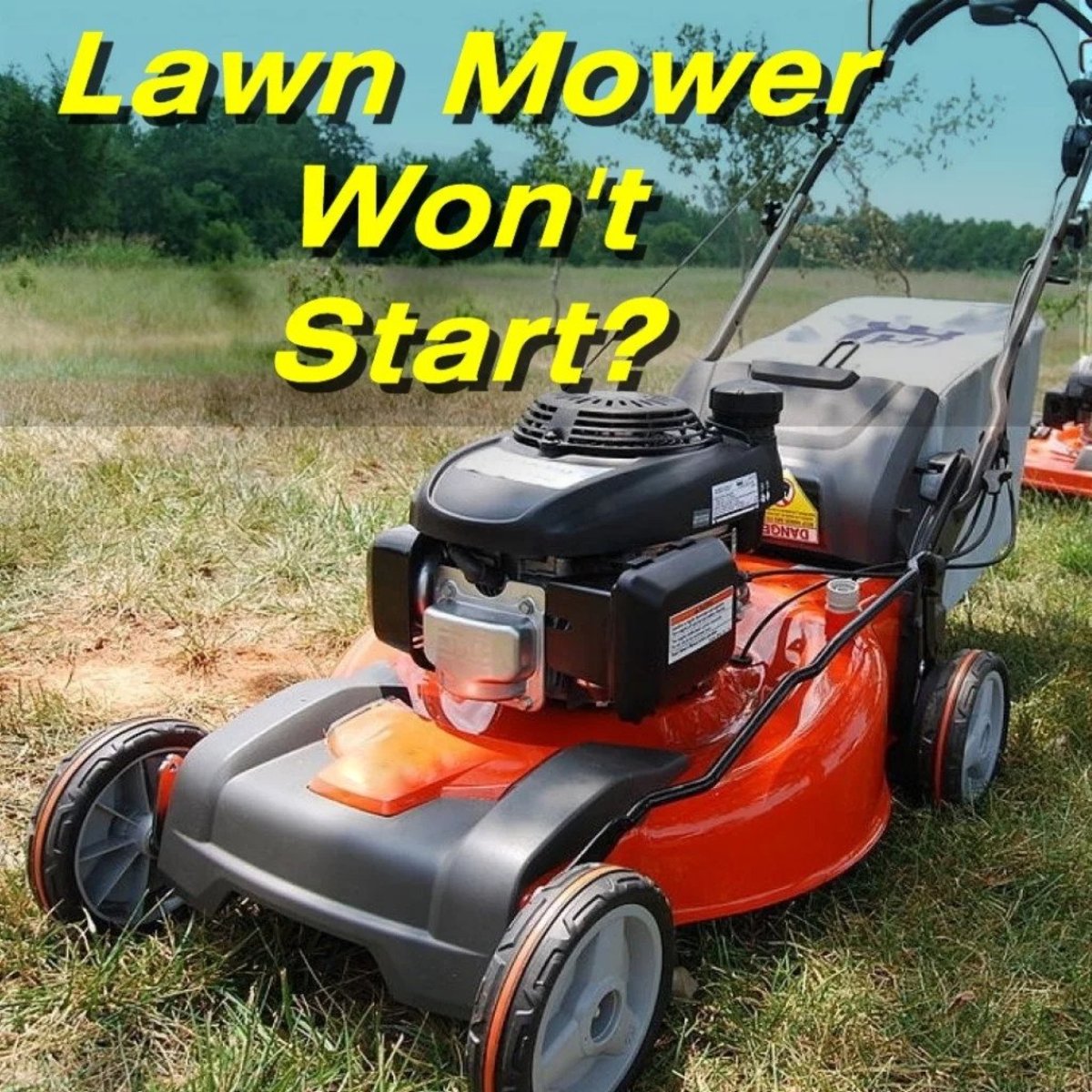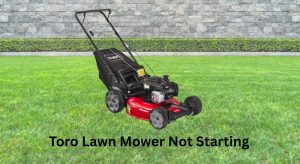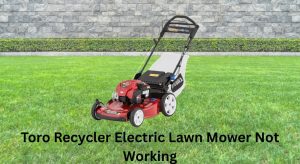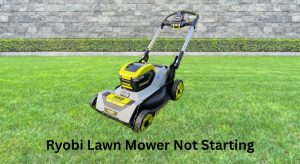Your lawn mower starter not working can turn a quick yard job into a frustrating time sink. The fastest fix is often simple: check the battery and connections (for electric start mowers) or the starter rope and recoil spring (for pull-start models). Tighten loose cables, clean corroded terminals, or replace a worn starter rope to get going in minutes.
In this guide, you’ll learn the most common causes of starter failure on both electric-start (battery/solenoid/starter motor) and pull-start (recoil) mowers, step-by-step fixes from basic to advanced, how to diagnose whether the problem is electrical or mechanical, and preventive maintenance to keep your mower starting reliably. By the end, you’ll know exactly what to check, how to fix it, and when to call a pro.
Common Causes of a Lawn Mower Starter Not Working

- Dead or weak battery (electric start)
- Corroded or loose battery terminals and cables
- Faulty ignition switch or safety interlock switch (blade/brake/seat)
- Bad starter solenoid or starter motor
- Blown fuse in the start circuit
- Stale fuel or flooded carburetor (feels like a starter issue)
- Seized engine or hydro-lock (oil/fuel in cylinder)
- Faulty spark plug or ignition coil
- Broken or jammed recoil assembly (pull-start)
- Sheared flywheel key (engine turns but won’t fire correctly)
How to Fix a Lawn Mower Starter Not Working

Below are multiple methods arranged from quick checks to advanced repairs. Use the path for your mower type (electric start vs pull-start), or follow Method 1 for universal basics.
Method 1: Quick Checks Most People Miss (All Mowers)
Diagnosing the Issue
- Symptom: No click/no crank on key turn; or pull rope stuck/returns slowly.
- Goal: Rule out simple issues in 5–10 minutes.
Fix Steps
- Ensure the mower is in Neutral with the parking brake engaged.
- Confirm all safety switches are satisfied:
– Blade disengaged (PTO off)
– Operator presence lever depressed (walk-behind)
– Sitting on seat (riding mowers) - Check fuel level and quality. If fuel is older than 30 days (without stabilizer), replace it.
- Inspect the spark plug wire: firmly seated and not corroded.
- For pull-start: Remove debris from around the flywheel and recoil housing.
Testing
- Try starting again. If there’s still no action, proceed based on your starter type.
Method 2: Electric Start Mowers — Battery and Cable Fix
Diagnosing the Issue
- Symptom: Single click, rapid clicking, or nothing when turning the key/push button.
- Likely causes: Weak battery, corroded terminals, bad ground.
Fix Steps
- Safety first: Remove key, disconnect spark plug wire.
- Access the battery. Measure voltage with a multimeter:
– 12V systems: Healthy at 12.6–12.8V. Below 12.2V is weak; below 12.0V likely won’t crank. - Charge the battery:
– Use a smart charger rated 1–3A for small batteries.
– Charge 4–8 hours, then retest voltage. If voltage drops quickly under load, battery may be bad. - Clean terminals:
– Disconnect negative (black) first, then positive (red).
– Neutralize corrosion with baking soda and water, scrub with a wire brush.
– Rinse and dry; apply dielectric grease if available.
– Reconnect positive first, then negative; tighten snugly. - Inspect cables and grounds:
– Look for frayed insulation, green corrosion under heat shrink, or loose lugs.
– Verify the ground strap to frame/engine is tight and on clean metal.
Testing
- Try to start. If you still hear clicking or nothing, proceed to solenoid/ignition checks.
Method 3: Electric Start — Solenoid and Starter Motor Diagnosis
Diagnosing the Issue
- Symptom: Battery good, but no crank or only a click. Lights work but starter doesn’t spin.
- Goal: Identify if the solenoid or starter motor is bad.
Fix Steps
- Locate the starter solenoid (usually near the battery; two large posts and a small trigger wire).
- Check the fuse in the start circuit (often near the solenoid or ignition switch). Replace if blown, and investigate shorts if it blows again.
- Test the solenoid:
– With key turned to Start, listen for a solid click at the solenoid.
– Measure voltage at the small trigger terminal when turning the key. You should see battery voltage (~12V).
– If no voltage, suspect ignition switch or safety interlock.
– If there is voltage but the large output post never gets power, the solenoid is bad. Replace it. - Bypass test (brief and careful):
– Warning: Sparks possible. Ensure mower is out of gear, brake set, and blades off.
– Use an insulated screwdriver to momentarily bridge the two large posts on the solenoid.
– If the engine cranks, the starter motor is likely good; replace the solenoid.
– If it doesn’t crank, suspect the starter motor or a poor ground. - Test the starter motor:
– Apply 12V directly to the starter’s positive terminal with a jumper cable; ground to engine block.
– If it spins strongly, wiring/solenoid is suspect; if not, replace or rebuild the starter.
Testing
- After replacement, start the mower several times to confirm consistent cranking.
Method 4: Safety Interlocks and Ignition Switch
Diagnosing the Issue
- Symptom: No click/no crank despite good battery. Starts only when jiggling levers/seat.
- Likely cause: Faulty seat switch, brake switch, PTO switch, or ignition switch.
Fix Steps
- Inspect each safety switch:
– Seat switch: Ensure it clicks and moves smoothly; check connector.
– Brake/neutral switch: Verify pedal fully depressed/lever in neutral.
– PTO switch: Must be off; faulty PTO switch often blocks starting. - Wiggle test:
– While attempting to start, gently wiggle harnesses/switches. If it cranks intermittently, you’ve found a bad connection or failing switch. - Test switches with a multimeter (continuity mode):
– Remove switch connectors. Check for continuity in the “safe” position, open in “unsafe.” - Ignition switch:
– Check for 12V output at the start terminal when key is turned to Start.
– Replace ignition switch if no output but power in.
Testing
- Start the mower multiple times after each fix to verify reliability.
Method 5: Pull-Start Mowers — Recoil Starter Repair
Diagnosing the Issue
- Symptom: Rope won’t pull, retracts slowly, or pulls freely without engaging engine.
- Likely causes: Jammed recoil, broken recoil spring, worn pawls, or frayed rope.
Fix Steps
- Safety first: Remove spark plug wire to prevent accidental start.
- Remove the recoil housing: Typically 3–6 screws on top cover.
- Inspect:
– Check for debris jamming the flywheel or recoil cup.
– Examine the starter rope for frays; replace if worn.
– Inspect pawls/dogs in the recoil; ensure they extend and retract smoothly. - Fix common issues:
– Clean and lightly lubricate pawls and pivot points (dry lube preferred).
– Replace broken recoil spring or rope. Pre-wind the spring per manufacturer’s directions.
– Ensure the recoil cup on the flywheel isn’t rounded or cracked; replace if worn. - Reassemble and ensure smooth rope action and strong recoil.
Testing
- Pull-start with spark plug wire reconnected. The rope should engage the engine firmly and retract briskly.
Method 6: Engine Won’t Turn or Turns Hard — Mechanical Checks
Diagnosing the Issue
- Symptom: Starter clicks but can’t turn engine; rope is hard to pull or locks up.
- Likely causes: Hydro-lock, low oil/seized engine, stuck blade, or sheared flywheel key.
Fix Steps
- Check oil level. If very low and engine is stuck, internal damage may have occurred.
- Inspect the blade:
– Disconnect spark plug wire; tip the mower carburetor-side up only.
– Remove obstructions or straighten/replace a bent blade that can bind. - Clear hydro-lock (common on small engines tipped incorrectly):
– Remove spark plug.
– Pull starter rope several times to expel fuel/oil from cylinder.
– Dry/replace spark plug; reinstall and try starting. - Flywheel key check (if engine backfires and rope jerks back):
– Remove flywheel nut and inspect key. If sheared, replace key and torque flywheel to spec.
Testing
- After clearing, engine should rotate smoothly by hand before using the starter.
Method 7: Fuel and Ignition Basics (When It “Starts” Issue Mimics Starter Failure)
Diagnosing the Issue
- Symptom: Starter spins the engine but it never fires; repeated attempts drain the battery.
- Likely causes: Stale fuel, clogged carburetor jet, bad spark plug, or failed ignition coil.
Fix Steps
- Replace old fuel; add fresh, ethanol-free if possible, or use stabilizer.
- Replace the spark plug (gap to spec; common small engines ~0.030 in/0.76 mm).
- Check for spark:
– Use an inline spark tester. Crank the engine; look for strong blue spark.
– No spark: inspect kill wire/stop switch; test and replace ignition coil if needed. - Carburetor:
– Clean the main jet and bowl; replace fuel filter; ensure the choke is operating.
Testing
- Engine should fire within a few seconds. Avoid extended cranking (limit to 10–15 seconds per attempt).
How to Prevent Future Starter Problems
- Keep the battery on a maintainer during off-season.
- Clean and protect terminals with dielectric grease every season.
- Store fuel with stabilizer; drain carb if storing 60+ days.
- Replace the starter rope and spark plug every 2–3 seasons or as needed.
- Inspect safety switches and wiring annually for wear and moisture damage.
- Avoid tipping the mower carburetor-side down; always tip spark plug side up or as the manual advises.
- Keep blades sharp and balanced to reduce engine stress.
Pro Tips
- Use a smart charger with a maintenance mode to maximize small battery life.
- A single solid click usually points to a weak battery or bad solenoid; rapid clicking screams low voltage.
- If the starter spins but the engine doesn’t turn, check for a worn or missing Bendix drive gear or flywheel ring gear (riders).
- Label and photograph wiring before removing parts; prevents miswiring on reassembly.
- When testing for hydro-lock, always remove the spark plug first — cranking against a locked cylinder can bend the starter shaft.
- Use contact cleaner on switch plugs instead of heavy oils; oils attract dirt and worsen connectivity over time.
- If your yard is dusty, blow out the starter and flywheel area with compressed air each month to prevent debris jams.
When to Call a Professional
- Persistent no-crank after battery, cable, and solenoid checks
- Grinding noises from starter engaging the flywheel (possible ring gear damage)
- Engine seized or low/no oil with metal shavings present
- Repeatedly blown starting fuses (indicates a short)
- Complex wiring faults in safety interlock circuits you can’t trace
What to look for in a service provider:
– Certified small-engine technician (Briggs & Stratton, Kawasaki, Kohler, Honda)
– Transparent diagnostic fees and written estimates
– Access to OEM parts and warranty support
– Turnaround time under 7–10 days during peak season
Typical costs (varies by region/model):
– Battery: $30–$80
– Solenoid: $15–$40
– Starter motor: $80–$200 (rider), $40–$100 (walk-behind)
– Recoil assembly: $30–$90
– Diagnostic labor: $60–$120/hr
Warranty considerations:
– Check your mower’s warranty before DIY disassembly on new equipment.
– Use OEM electrical parts when under warranty to avoid claim issues.
FAQ
Q: My mower only clicks when I turn the key. What’s wrong?
A: A single click usually means the solenoid is trying to engage but battery voltage is too low or there’s high resistance in the cables. Charge the battery, clean/tighten terminals, and test the solenoid. If battery and cables are good, replace the solenoid.
Q: The starter spins but the engine doesn’t turn over. Why?
A: The starter’s Bendix gear may not be engaging the flywheel, or the flywheel ring gear is worn. Inspect the starter drive gear for wear and ensure it extends under power. Replace the drive or starter; inspect the ring gear if engagement sounds like free-spinning.
Q: My pull cord is stuck. Is my engine seized?
A: Not necessarily. The recoil can jam with debris, or the blade could be lodged. Disconnect the spark plug, remove debris, and try rotating the blade hub by hand. If it still won’t move, check oil level and try removing the spark plug to rule out hydro-lock. A dry, immovable crankshaft may indicate seizure.
Q: How long should I charge a lawn mower battery?
A: Use a 1–3A smart charger for 4–8 hours. A healthy 12V battery will rest at 12.6–12.8V. If it quickly drops below 12.2V after charging or can’t crank the engine, it likely needs replacement.
Q: What safety switches can stop my mower from starting?
A: Common interlocks include seat, brake/neutral, blade PTO, and operator presence (handle) switches. Any faulty or misadjusted switch can prevent cranking. Test for continuity and ensure all are in the safe position.
Q: Can bad fuel make it seem like the starter is failing?
A: Yes. If the engine doesn’t fire, you may keep cranking until the battery dies, making it look like a starter issue. Replace stale fuel, check spark, and clean the carburetor jet if needed.
Q: Is it okay to jump-start a riding mower with a car?
A: You can, but it’s safer to use a small engine-rated charger or jump pack. If using a car, keep the car engine off to avoid voltage spikes. Observe correct polarity and disconnect immediately after starting.
Q: Why does my starter rope snap back violently?
A: This can indicate incorrect ignition timing or a partially sheared flywheel key, often after hitting a rock. Inspect and replace the key; torque the flywheel nut to spec.
Alternative Solutions
Sometimes repair isn’t the best path, especially on older equipment.
| Solution | Pros | Cons | Best For |
|---|---|---|---|
| Replace battery/solenoid/starter as a set | Restores reliability fast | Higher upfront cost | Older riders with repeated start issues |
| Convert to manual shutoff and fuel stabilizer routine | Prevents fuel-related no-starts | Requires habit change | Seasonal users |
| Replace mower with brushless electric model | Instant starts, low maintenance | Higher initial cost, battery lifespan | Small to medium lawns, light upkeep |
| Professional seasonal tune-up | Comprehensive prevention | Service cost, downtime | Users short on time or tools |
Get Your Lawn Mower Working Again
Use this guide to pinpoint why your lawn mower starter not working is keeping you off the grass and fix it with confidence:
– Start with quick checks: safety switches, fuel quality, spark plug wire.
– For electric start: test/charge the battery, clean terminals, inspect solenoid and starter.
– For pull-start: service the recoil, rope, and pawls; clear jams.
– If the engine won’t turn: check for hydro-lock, blade obstructions, or a sheared flywheel key.
– Prevent future problems with seasonal battery care, clean connections, and fresh fuel.
Don’t let a small starting issue delay your mowing schedule. Work through the steps in order, and you’ll have your mower cranking reliably again. Still stuck? Describe your exact symptoms in the comments for tailored advice—and share what fix worked for you to help other readers. Found this helpful? Bookmark it for the next tune-up.





